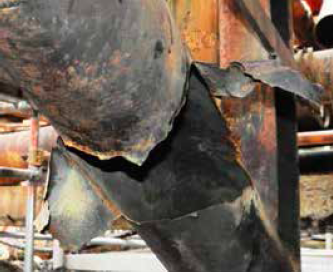| This article is part 5 of a 5-part series. |
| Part 1 | Part 2 | Part 3 |
| Part 4 | Part 5 |
Introduction
Piping failures still represent a frustrating and ongoing problem for processing plants (example in Figure 1). Failures are still commonly reported and contribute to large losses. “Five year loss totals in the refining sector have continued to trend upwards over the last few years. While the 2002–2006 period presented a drop in losses, the increasing trend is unlikely to have abated. Piping failures or leaks (corrosion or incorrect metallurgy) and start-up and shut-down events continue to be significant causes.” In the author’s experience, piping represents the highest percentage of fixed equipment failures in petroleum refining. Of course, there are many factors within a pressure equipment integrity program (PEIP) that can contribute to piping integrity problems including design issues, operating window compliance, management of change issues, etc.

This article is the fifth of a series of articles that will focus on one critical sub process within a PEIP that is key in managing the integrity of process piping; Thickness Monitoring Programs for Internal Corrosion. These articles will discuss what constitutes an effective piping thickness monitoring process and present some practices that may be new to some readers. These practices have produced beneficial results in major piping reliability programs. The first article (September/October 2012 Inspectioneering Journal) provided an overview of this process as outlined in Figure 2. The second article (November/December 2012 Inspectioneering Journal) discussed the considerations that enter into determining the number and position of corrosion monitoring locations (CMLs). A third article (January/February 2013 Inspectioneering Journal) discussed the use and the pros and cons of ultrasonic (UT) and radiography (RT) thickness data collection techniques. The fourth article (May/June 2013 Inspectioneering Journal) discussed the elements of ensuring that thickness measurement inspection (TMI) provides quality thickness data as part of the thickness management process (TMP) such that the data is non-spurious and useful in assessing piping condition accurately.
This article, the last of this series, will introduce the concept of performing data analysis, not on a single TML basis, but rather on the entire data set generated during a TMI of a piping circuit. It is important to keep in mind that this series of articles focuses only on thinning or corrosion, which in many, but not all plants is the most prevalent form of degradation. However, there are numerous other mechanisms that can lead to piping failures such as corrosion under insulation, high temperature creep, fatigue, de-alloying, environmentally assisted cracking (e.g. chloride SCC), etc. Effective inspection strategies should be developed to detect the particular types of anticipated or potential damage as appropriate.

















Comments and Discussion
Add a Comment
Please log in or register to participate in comments and discussions.